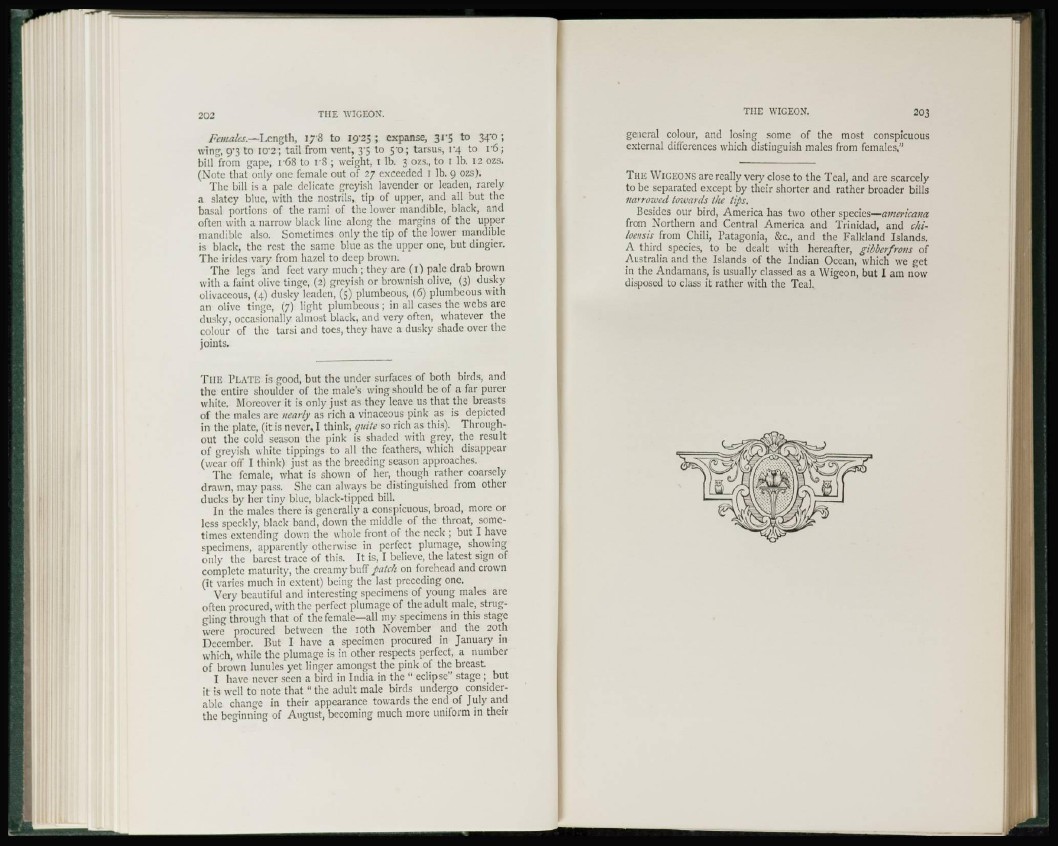
202 THE WIGEON.
Females.—Length, 1 7 8 to 19-25; expanse, 31-5 to 34-0;
wing, 9"3 to 10-2; tail from vent, 35 to 5-0; tarsus, 1-4 to r 6;
bill from gape, r68 to r 8 ; weight, 1 lb. 3 ozs., to 1 lb. 12 ozs.
(Note that only one female out of 27 exceeded I lb. 9 ozs).
The bill is a pale delicate greyish lavender or leaden, rarely
a slatcy blue, with the nostrils, tip of upper, and all but the
basal portions of the rami of the lower mandible, black, and
often with a narrow black line along the margins of the upper
mandible also. Sometimes only the tip of the lower mandible
is black, the rest the same blue as the upper one, but dingier.
The irides vary from hazel to deep brown.
The legs and feet vary much ; they are (1) pale drab brown
with a faint olive tinge, (2) greyish or brownish olive, (3) dusky
olivaceous, (4) dusky leaden, (5) plumbeous, (6) plumbeous with
an olive tinge, (7) light plumbeous ; in all cases the webs are
dusky, occasionally almost black, and very often, whatever the
colour of the tarsi and toes, they have a dusky shade over the
joints.
THE PLATE is good, but the under surfaces of both birds, and
the entire shoulder of the male's wing should be of a far purer
white. Moreover it is only just as they leave us that the breasts
of the males are nearly as rich a vinaceous pink as is depicted
in the plate, (it is never, I think, quite so rich as this). Throughout
the cold season the pink is shaded with grey, the result
of greyish white tippings to all the feathers, which disappear
(wear off I think) just as the breeding season approaches.
The female, what is shown of her, though rather coarsely
drawn, may pass. She can always be distinguished from other
ducks by her tiny blue, black-tipped bill.
In the males there is generally a conspicuous, broad, more or
less spcckly, black band, down the middle of the throat, sometimes
extending down the whole front of the neck ; but I have
specimens, apparently otherwise in perfect plumage, showing
only the barest trace of this. It is, I believe, the latest sign of
complete maturity, the creamy buff patch on forehead and crown
(it varies much in extent) being the last preceding one.
Very beautiful and interesting specimens of young males are
often procured, with the perfect plumage of the adult male, struggling
through that of the female—all my specimens in this stage
were procured between the 10th November and the 20th
December. But I have a specimen procured in January in
which, while the plumage is in other respects perfect, a number
of brown lunules yet linger amongst the pink of the breast.
I have never seen a bird in India in the " eclipse" stage ; but
it is well to note that "the adult male birds undergo considerable
change in their appearance towards the end of July and
the beginning of August, becoming much more uniform in their
THE WICEON. 203
general colour, and losing some of the most conspicuous
external differences which distinguish males from females."
THE WlGEONS are really very close to the Teal, and are scarcely
to be separated except by their shorter and rather broader bills
narrowed towards the tips.
Besides our bird, America has two other species—aincricana
from Northern and Central America and Trinidad, and chiloensis
from Chili, Patagonia, &c, and the Falkland Islands.
A third species, to be dealt with hereafter, gibberfro?is of
Australia and the Islands of the Indian Ocean, which we get
in the Andamans, is usually classed as a Wigeon, but I am now
disposed to class it rather with the Teal.